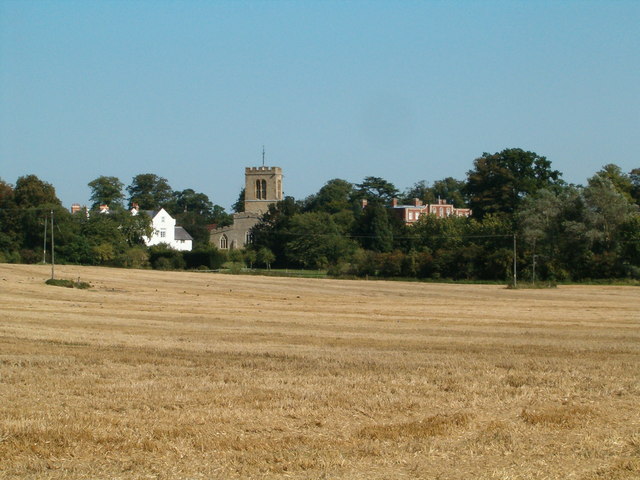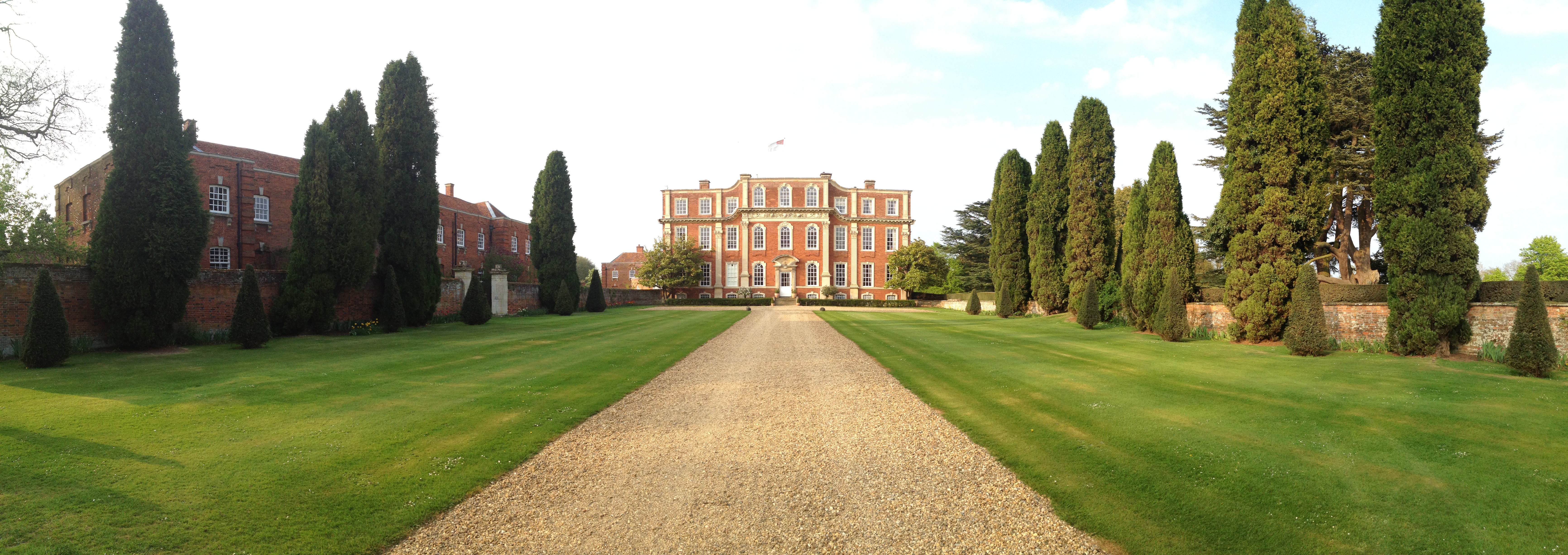|
Chicheley Hall
Chicheley Hall, Chicheley, Buckinghamshire, England is a country house built in the first quarter of the 18th century. The client was Sir John Chester, the main architect was Francis Smith of Warwick and the architectural style is Baroque. Later owners included David Beatty, 2nd Earl Beatty and the Royal Society. Chicheley Hall is a Grade I listed building. History Earlier buildings A manor house on the site belonged to the Pagnell family of Newport Pagnell, but was donated by them to the church. Cardinal Wolsey gave the manor to Christ Church, Oxford, but it subsequently reverted to the Crown after Wolsey's fall and was acquired by a wool merchant, Anthony Cave, in 1545, who built a manor house in the form of a hollow square. On his death the house was left to his daughter Judith, who had married her cousin William Chester, son of Sir William Chester. Their only son Anthony was High Sheriff of Buckinghamshire for 1602 and created a baronet in 1620. The house then descended in t ... [...More Info...] [...Related Items...] OR: [Wikipedia] [Google] [Baidu] |
Chicheley
Chicheley is a village and civil parish in the unitary authority area of the City of Milton Keynes, Buckinghamshire, England. The village is about north-east of Newport Pagnell. The village name is Anglo-Saxon in origin, and means ''Cicca's clearing''. In the Domesday Book of 1086, the village was recorded as ''Cicelai''.'Parishes : Chicheley' , A History of the County of Buckingham: Volume 4 (1927), pp. 311-316. The manor of Chicheley (which some suggest may have once been called Thickthorn) anciently b ... [...More Info...] [...Related Items...] OR: [Wikipedia] [Google] [Baidu] |
Jacobean Architecture
The Jacobean style is the second phase of Renaissance architecture in England, following the Elizabethan style. It is named after King James VI and I, with whose reign (1603–1625 in England) it is associated. At the start of James' reign there was little stylistic break in architecture, as Elizabethan trends continued their development. However, his death in 1625 came as a decisive change towards more classical architecture, with Italian influence, was in progress, led by Inigo Jones; the style this began is sometimes called Stuart architecture, or English Baroque (though the latter term may be regarded as starting later). Courtiers continued to build large prodigy houses, even though James spent less time on summer progresses round his realm than Elizabeth had. The influence of Flemish and German Northern Mannerism increased, now often executed by immigrant craftsmen and artists, rather than obtained from books as in the previous reign. There continued to be very little build ... [...More Info...] [...Related Items...] OR: [Wikipedia] [Google] [Baidu] |
Cello
The cello ( ; plural ''celli'' or ''cellos'') or violoncello ( ; ) is a Bow (music), bowed (sometimes pizzicato, plucked and occasionally col legno, hit) string instrument of the violin family. Its four strings are usually intonation (music), tuned in perfect fifths: from low to high, scientific pitch notation, C2, G2, D3 and A3. The viola's four strings are each an octave higher. Music for the cello is generally written in the bass clef, with tenor clef, and treble clef used for higher-range passages. Played by a ''List of cellists, cellist'' or ''violoncellist'', it enjoys a large solo repertoire Cello sonata, with and List of solo cello pieces, without accompaniment, as well as numerous cello concerto, concerti. As a solo instrument, the cello uses its whole range, from bassline, bass to soprano, and in chamber music such as string quartets and the orchestra's string section, it often plays the bass part, where it may be reinforced an octave lower by the double basses. Figure ... [...More Info...] [...Related Items...] OR: [Wikipedia] [Google] [Baidu] |
Gwen Farrar
Gwendoline "Gwen" Farrar (14 July 1897 – 25 December 1944) was an English duettist, cellist, singer, actress and comedian. Early life Gwendoline Farrar was born on 14 July 1897, at 108 Park Street, London. She was the third daughter of Sir George Farrar, a prominent figure in South African mining and politics, and Ella Mabel Waylen (c.1869–1922). She attended Heathfield School briefly and then trained as a classical cellist with Herbert Walenn. She received her LRAM in 1917. Career She became famous after the World War I in partnership with Norah Blaney. Between 1921 and 1924 they appeared at leading London and provincial variety theatres, as well as in the cabaret shows: ''Pot Luck!'' (1921), starring Jack Hulbert and Beatrice Lillie; ''Rats'' (1923), starring Alfred Lester and Gertrude Lawrence; ''Yes!'' (1923), starring A. W. Bascomb, Norah Blaney and Gwen Farrar, all of which were presented by André Charlot at the Vaudeville Theatre, Strand, London; ''The Punch Bowl'' (1 ... [...More Info...] [...Related Items...] OR: [Wikipedia] [Google] [Baidu] |
Randlord
Randlords were the capitalists who controlled the diamond and gold mining industries in South Africa in its pioneer phase from the 1870s up to World War I. A small number of European financiers, largely of the same generation, gained control of the diamond mining industry at Kimberley, Northern Cape. They set up an infrastructure of financing and industrial consolidation which they then applied to exploit the discoveries of gold from 1886 in Transvaal at Witwatersrand — the "Rand". Once based in the Transvaal, many set up residence in the mansions of Parktown. Many of the Randlords received baronetcies in recognition of their contributions. Notable Randlords * Sir George Albu, 1st Bt (1857–1935)' * Leopold Albu (1861–1938) * Sir Abe Bailey, 1st Bt (1864–1940) * Barney Barnato (1852–1897) *Alfred Beit (1853–1906) * Sir Otto Beit, 1st Bt (1865–1930) *Hermann Ludwig Eckstein (1847–1893) * Sir George Herbert Farrar (1859–1915) *Adolf Goerz (1857–1900) *John Hays ... [...More Info...] [...Related Items...] OR: [Wikipedia] [Google] [Baidu] |
George Farrar
Sir George Herbert Farrar, 1st Baronet, (17 June 1859 – 20 May 1915) was a South African mining magnate, politician and soldier – Colonel and assistant Quartermaster General – Central Force, Union Defence Force (South Africa), Union Defence Force, Hon. Colonel Light Horse Regiment, South African Light Horse. Early life and career Farrar was born in 1859 in Chatteris, Cambridgeshire, the son of Charles Farrar, a Chatteris medical doctor, and Helen Howard, the daughter of John Howard of Cauldwell House Bedford and sister of Frederick Howard (industrialist), Sir Frederick Howard of Bedford and James Howard (agriculturalist), James Howard MP of Bedford. George Herbert Farrar was educated at Bedford Modern School after which he joined Howard, Farrar & Co., the engineering business of his uncle, Frederick Howard (industrialist), Sir Frederick Howard, travelling to South Africa in 1879 to work at the firm's branches in Port Elizabeth and East London, South Africa, East London. He ... [...More Info...] [...Related Items...] OR: [Wikipedia] [Google] [Baidu] |
Charles Bagot Chester
Charles Bagot Chester (25 October 1770 – 1 June 1838), of Chicheley Hall, Buckinghamshire, was an English politician. He was the eldest son of merchant Charles Bagot Chester, born Charles Bagot, who had adopted the name of Chester in 1755 when he inherited Chicheley Hall and other estates from his cousin Sir Charles Bagot Chester, 7th Baronet. Charles jnr was educated at Westminster School (1783-8) and Christ Church, Oxford (1788) and succeeded his father in 1793. He was a Member of Parliament (MP) of the Parliament of Great Britain for Castle Rising from 14 July 1794 to 1807. More interested in fashion, horse racing and gambling than politics, he had to sell some of his estates to settle his debts. In 1822 his sister Mary Jenkinson, Countess of Liverpool married the then Prime Minister A prime minister, premier or chief of cabinet is the head of the cabinet and the leader of the ministers in the executive branch of government, often in a parliamentary or semi ... [...More Info...] [...Related Items...] OR: [Wikipedia] [Google] [Baidu] |
Gervase Jackson-Stops
Gervase Frank Ashworth Jackson-Stops (26 April 1947 – 2 July 1995, in London) was an architectural historian and journalist. Education He was educated at Harrow School, Harrow and later won an exhibition (scholarship), exhibition to Christ Church, Oxford and here he was amused that his tutor put down on his list as required reading Burke's Peerage. His grandfather, Herbert Jackson-Stops, founded the eponymous and up-market estate agency. He trained with a Museums Association Studentship at the Victoria and Albert Museum from 1969–71 and as a research assistant at the National Trust for Places of Historic Interest or Natural Beauty, National Trust between 1972 & 75. National Trust He was the Architectural Adviser to the National Trust for over 20 years, earning enormous respect as result of which he broke fresh ground when he fought for the rescue of the decaying Northamptonshire manor-house at Canons Ashby House, Canons Ashby. It was the first time that Government fun ... [...More Info...] [...Related Items...] OR: [Wikipedia] [Google] [Baidu] |



.jpg)
